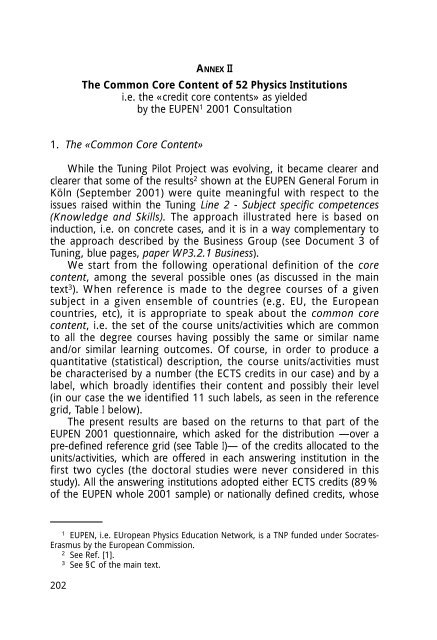Final Report Pilot Project - Relaciones Internacionales de la ...
Final Report Pilot Project - Relaciones Internacionales de la ...
Final Report Pilot Project - Relaciones Internacionales de la ...
You also want an ePaper? Increase the reach of your titles
YUMPU automatically turns print PDFs into web optimized ePapers that Google loves.
ANNEX II<br />
The Common Core Content of 52 Physics Institutions<br />
i.e. the «credit core contents» as yiel<strong>de</strong>d<br />
by the EUPEN 1 2001 Consultation<br />
1. The «Common Core Content»<br />
While the Tuning <strong>Pilot</strong> <strong>Project</strong> was evolving, it became clearer and<br />
clearer that some of the results 2 shown at the EUPEN General Forum in<br />
Köln (September 2001) were quite meaningful with respect to the<br />
issues raised within the Tuning Line 2 - Subject specific competences<br />
(Knowledge and Skills). The approach illustrated here is based on<br />
induction, i.e. on concrete cases, and it is in a way complementary to<br />
the approach <strong>de</strong>scribed by the Business Group (see Document 3 of<br />
Tuning, blue pages, paper WP3.2.1 Business).<br />
We start from the following operational <strong>de</strong>finition of the core<br />
content, among the several possible ones (as discussed in the main<br />
text 3 ). When reference is ma<strong>de</strong> to the <strong>de</strong>gree courses of a given<br />
subject in a given ensemble of countries (e.g. EU, the European<br />
countries, etc), it is appropriate to speak about the common core<br />
content, i.e. the set of the course units/activities which are common<br />
to all the <strong>de</strong>gree courses having possibly the same or simi<strong>la</strong>r name<br />
and/or simi<strong>la</strong>r learning outcomes. Of course, in or<strong>de</strong>r to produce a<br />
quantitative (statistical) <strong>de</strong>scription, the course units/activities must<br />
be characterised by a number (the ECTS credits in our case) and by a<br />
<strong>la</strong>bel, which broadly i<strong>de</strong>ntifies their content and possibly their level<br />
(in our case the we i<strong>de</strong>ntified 11 such <strong>la</strong>bels, as seen in the reference<br />
grid, Table I below).<br />
The present results are based on the returns to that part of the<br />
EUPEN 2001 questionnaire, which asked for the distribution —over a<br />
pre-<strong>de</strong>fined reference grid (see Table I)— of the credits allocated to the<br />
units/activities, which are offered in each answering institution in the<br />
first two cycles (the doctoral studies were never consi<strong>de</strong>red in this<br />
study). All the answering institutions adopted either ECTS credits (89 %<br />
of the EUPEN whole 2001 sample) or nationally <strong>de</strong>fined credits, whose<br />
1 EUPEN, i.e. EUropean Physics Education Network, is a TNP fun<strong>de</strong>d un<strong>de</strong>r Socrates-<br />
Erasmus by the European Commission.<br />
2 See Ref. [1].<br />
3 See §C of the main text.<br />
202


